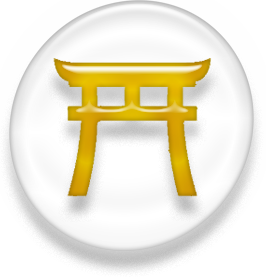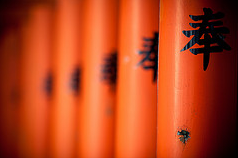

The most common Shinto symbol, which represents a torii (shrine gate).
Image: Shinto Torii Icon Gold created by Tinette is Licensed under a GNU Free Documentation License.
 I Am Shinto
by
I Am Shinto
by
 Shinto a Short History
by
Shinto a Short History
by
 Shinto Nature, Gods, and Man in Japan
by
Shinto Nature, Gods, and Man in Japan
by

SHINTOISM BL2216 - BL2227.8
The term Shinto covers a many-hued array of Japanese religious traditions. In the Japan of today, these are represented by a considerable number of organized religious groups, an even larger number of more or less organized local shrine cults, and an ill-defined body of unorganized beliefs and practices that do not involve religious professionals. To the outside observer Shinto appears less as a distinct religion, than as an extremely fluid body of religious phenomena linked, at best, by a family resemblance.
What defines these disparate phenomena as aspects of Shinto, is not so much shared beliefs, ideas or moral attitudes, but rather a common set of physical symbols and ritual patterns. There is no scripture, no set of dogmas, nor even a shared pantheon that could warrant the lumping together of Shinto’s multifarious traditions under one label. Rather, practices are identified as some form of Shinto by such markers as the torii gate and shimenawa straw ropes, used to demarcate sacred spaces or objects; by branches of the evergreen sakaki tree, used as offerings or for purification; by shrine buildings with readily identifiable characteristics that set them apart from both Buddhist temples and the churches of established and new religions; and by the use of mirrors to signal the presence of the kami or deities.
From Shinto, A Short History, Inoue Nobutaka (editor) -- available on Net Library

Image: Repetition by Stefan Lins is licensed under a Creative Commons License.
The library subscribes to thousands of electronic books. A search using the search term SHINTOISM brought back 7 results. Select the link above and start searching.
 Historical Dictionary of Shinto
by
Historical Dictionary of Shinto
by
 Occult Japan : Shinto, Shamanism, and the Way of the Gods
by
Occult Japan : Shinto, Shamanism, and the Way of the Gods
by
 A Study of Shinto: The Religion of the Japanese Nation
by
A Study of Shinto: The Religion of the Japanese Nation
by